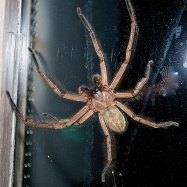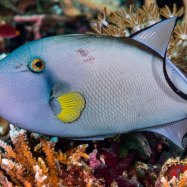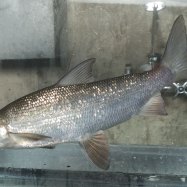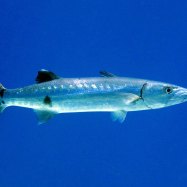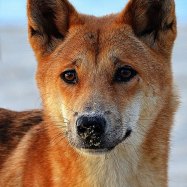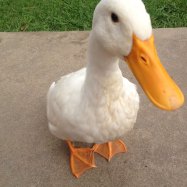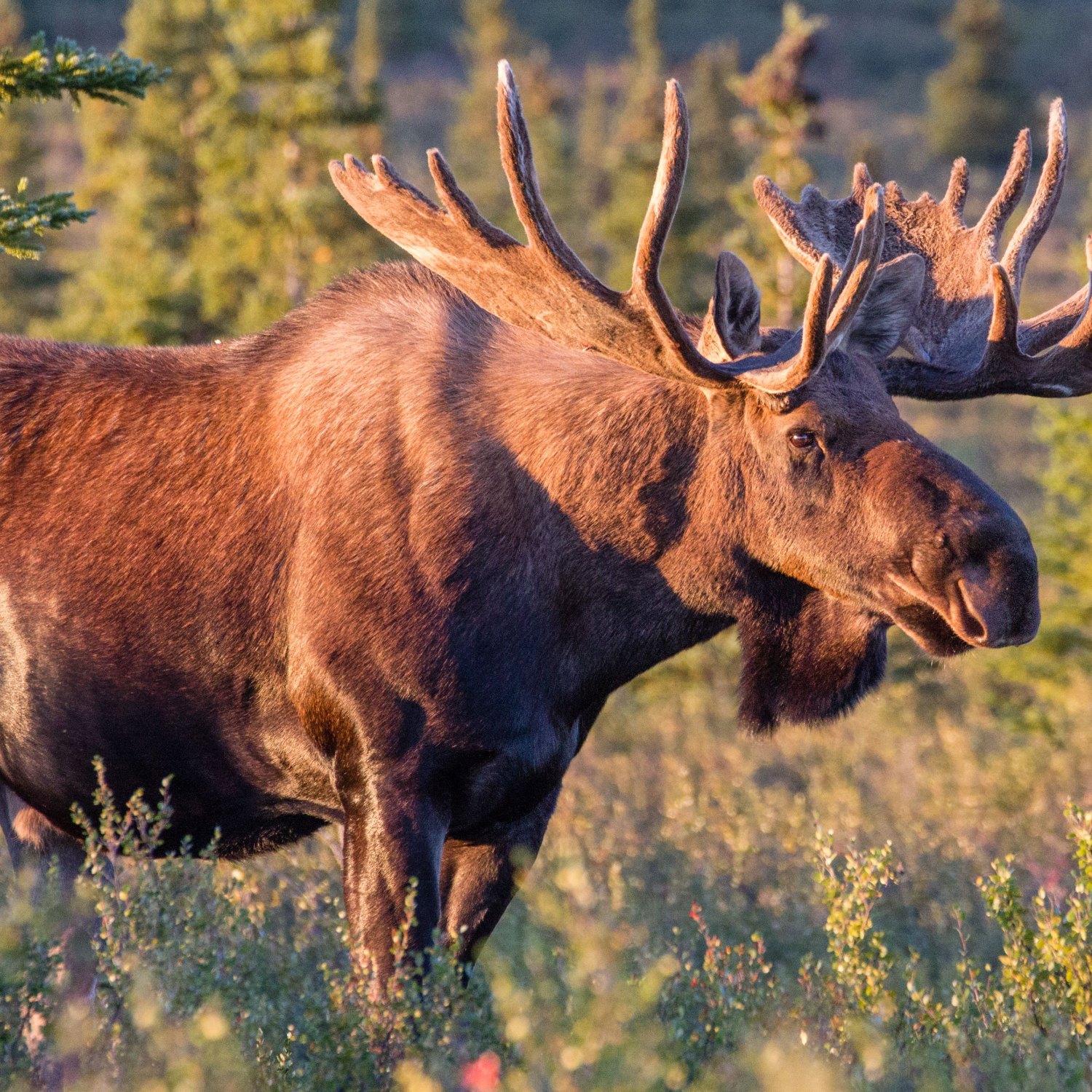
Moose
6-7.6 feet (1.8-2.3 meters)
The majestic moose is a symbol of power and grace in the animal kingdom. With a length of 6-7.6 feet and a muscular body, these creatures are true giants of the Northern regions of the world. Belonging to the Cervidae family, moose are known for their impressive antlers and docile nature, making them a sight to behold in their natural habitat.
Animal Details Summary:
Common Name: Moose
Kingdom: Animalia
Habitat: Forests, swamps, and marshes
Mighty Moose: The King of the Northern Forests
The sight of a moose is truly awe-inspiring. With its majestic antlers and towering stature, the moose is a true symbol of strength and power. But there is so much more to this magnificent animal than meets the eye. A closer look at its biology, behavior, and habitat reveals a fascinating creature that has captured the hearts of people all over the world Moose. Let's delve deeper into the world of the mighty moose – the king of the northern forests.Introduction to the Moose
Scientifically known as Alces alces, the moose is a large and iconic mammal that belongs to the family Cervidae, which includes deer, elk, and caribou. It is commonly referred to as the moose in North America and Eurasia, while it is known as an elk in the rest of the world. However, it is important to clarify that the North American elk is a different species altogether.Classification of the Moose
Moose are classified within the Kingdom Animalia, Phylum Chordata, Class Mammalia, Order Artiodactyla, and Family Cervidae. This means that they share similarities with other mammals such as elephants, giraffes, and whales. In the animal kingdom, they are considered herbivorous, feeding mainly on plants and vegetation.Habitat and Geographical Distribution
Moose are primarily found in the northern regions of the world, inhabiting forests, swamps, and marshes. They are commonly found in North America, Europe, and Asia, with their largest population in North America Mudi. In fact, they are the largest species of deer in the world and are only second in size after the elk.In North America, moose can be found in Canada, Alaska, and some northern states in the United States. In Europe, they are found in countries such as Sweden, Finland, and Norway. In Asia, they are found in Russia and parts of China. This widespread distribution is due to their ability to adapt to different environments and thrive in a variety of habitats.
Appearance and Physical Characteristics
One of the most striking features of a moose is its size. They are known to be one of the largest land mammals in the world. Their body shape is large and muscular, with a humped back and long, slender legs. They can weigh anywhere between 840 to 1,500 pounds and can reach a height of 6-7.6 feet, making them a formidable sight to behold.The coloration of a moose is another distinguishing feature. They have dark brown fur with a distinctive "dewlap" or flap of skin hanging from their throat, which is often lighter in color. This dewlap is more prominent in males and plays a role in attracting females during the mating season.
However, the most iconic feature of a moose is undoubtedly its antlers. They are the largest antlers among all deer species and can reach a width of up to 6 feet! Each year, moose shed their antlers, and they grow back bigger and more elaborate with each passing year.
Feeding Behavior of Moose
As mentioned earlier, moose are herbivorous animals, which means they primarily feed on plants and vegetation. They are browsers, meaning they feed on leaves, twigs, and buds of trees and shrubs. During the summer season, they feed on aquatic plants as well.One of the reasons why moose are so vital to the ecosystem is that they are considered "keystone species." This means that they have a significant impact on their environment and the species around them. Their browsing behavior helps to shape the landscape and create diverse habitats for other animals.
Mating Behavior and Reproduction
Moose have a unique mating ritual that takes place during the autumn season. Male moose, also known as bulls, use their intimidating size and elaborate antlers to attract females, also known as cows. They are solitary animals, so these displays of dominance often help them find and attract potential mates.Once the female chooses a mate, their courtship begins, and they engage in a behavior known as "clashing." This involves the bulls bashing their antlers together in a test of strength, with the winner earning the rights to mate with the female.
After mating, the female gives birth to one or two calves in the spring. Newborn moose are known as calves, and they are dependent on their mothers for the first year of their lives. Moose calves have a distinctive white spotted coat, which helps them blend in with their surroundings and provides protection from predators.
Threats to Moose
While moose may seem like powerful and invincible creatures, they face numerous threats in the wild. The most significant threat to moose is habitat loss due to human activity. As urbanization and development increase, the natural habitats of moose are being destroyed, leaving them with limited resources and space to survive.Moose are also vulnerable to climate change. Changes in weather patterns and habitat disruption can affect their food supply, while extreme weather events can also harm or even kill them. In addition, warmer climates can lead to an increase in parasites and diseases that can be detrimental to moose populations.
Furthermore, moose are also hunted for their meat and body parts. While hunting is regulated and controlled in most countries, illegal poaching still occurs, posing a significant threat to the fragile moose population.
Conservation Efforts
Thankfully, there are many conservation efforts in place to protect the moose and their habitat. In some areas, hunting is strictly regulated, and there are laws in place to protect moose and their habitats from human interference.Efforts are also being made to educate the public about the importance of preserving moose populations and their natural habitats. This includes educating people about responsible hunting practices and the impacts of climate change on the moose population.
The Importance of the Moose in Indigenous Culture
The moose holds a significant cultural and spiritual significance in many indigenous communities. For thousands of years, these communities have relied on the moose as a source of food, clothing, and shelter. As a result, the moose is often considered a sacred animal in these cultures.For example, the moose is an essential part of the Inuit culture, who rely heavily on the animal for sustenance and survival in the harsh Arctic environment. In Inuit mythology, the moose is often depicted as a powerful and noble creature, symbolizing strength and endurance.
Overall, the moose is a vital part of the ecosystem and holds immense cultural significance in many communities. Its majestic presence and impressive characteristics make it a beloved and respected animal in the northern regions of the world.
Conclusion
In conclusion, the mighty moose is more than just a symbol of strength and power. It is a crucial part of the ecosystem, a magnificent creature with unique adaptations, and an important cultural icon. Despite the challenges and threats it faces, the moose continues to capture the hearts and minds of people all over the world. It is our responsibility to protect and preserve this majestic animal for generations to come.

Moose
Animal Details Moose - Scientific Name: Alces alces
- Category: Animals M
- Scientific Name: Alces alces
- Common Name: Moose
- Kingdom: Animalia
- Phylum: Chordata
- Class: Mammalia
- Order: Artiodactyla
- Family: Cervidae
- Habitat: Forests, swamps, and marshes
- Feeding Method: Herbivorous
- Geographical Distribution: North America, Europe, Asia
- Country of Origin: Canada
- Location: Northern regions of the world
- Animal Coloration: Dark brown
- Body Shape: Large and muscular
- Length: 6-7.6 feet (1.8-2.3 meters)
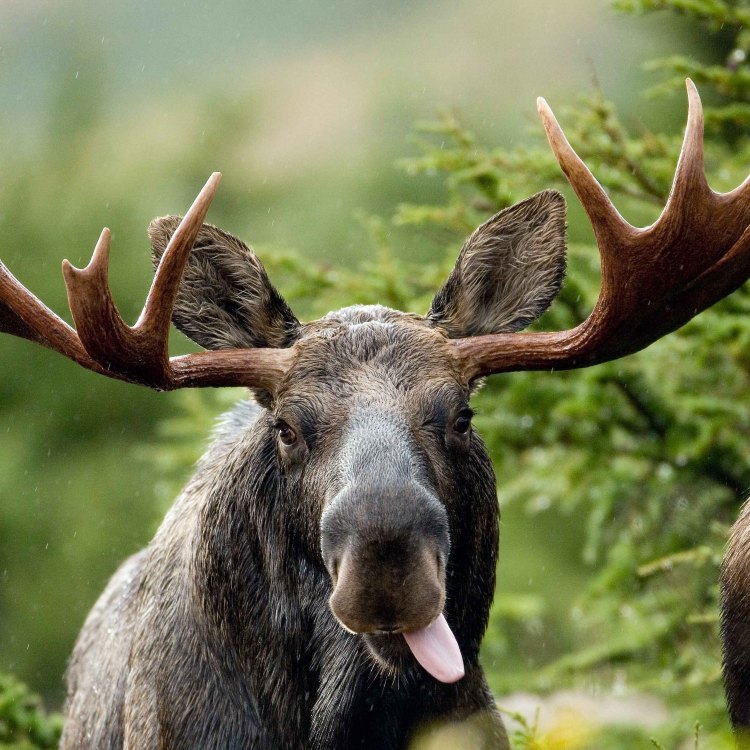
Moose
- Adult Size: Height at shoulder: 4.6-6.9 feet (1.4-2.1 meters), Weight: 800-1,500 pounds (360-680 kilograms)
- Average Lifespan: 15-25 years
- Reproduction: Sexual
- Reproductive Behavior: Polygamous
- Sound or Call: Mating calls
- Migration Pattern: Seasonal migrations
- Social Groups: Solitary or small groups
- Behavior: Mostly active during dawn and dusk
- Threats: Hunting, habitat loss, climate change
- Conservation Status: Least Concern
- Impact on Ecosystem: Important herbivores, contribute to controlling vegetation growth
- Human Use: Hunting, tourism
- Distinctive Features: Large antlers, prominent snout, hump on shoulders
- Interesting Facts: Moose are the largest species in the deer family. They are excellent swimmers and can dive up to 5 meters deep. Moose have a specialized nose that helps them warm the air they breathe in cold environments.
- Predator: Wolves, bears
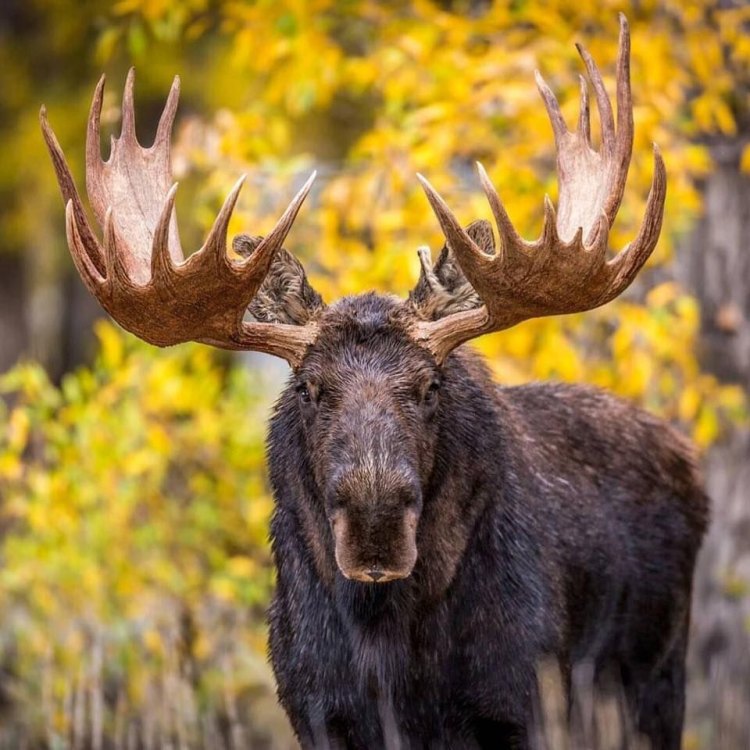
Alces alces
The Mighty Moose: A Fascinating Look at Nature's Largest Deer
Nature is full of wonders and fascinating creatures, but one species stands out for its impressive size and unique features. The moose, also known as elk in Europe, is a majestic and powerful animal that roams the northern regions of the world. From its massive antlers to its specialized nose, the moose is a true wonder of evolution.In this article, we will explore the amazing characteristics of the moose, its behavior, threats it faces, and its impact on the ecosystem PeaceOfAnimals.Com. Join us on this journey to discover the secrets of the mighty moose.
Physical Appearance
The moose is the largest species in the deer family, weighing between 800 to 1,500 pounds (360-680 kilograms) and measuring 4.6-6.9 feet (1.4-2.1 meters) at the shoulder. Its massive body is covered in thick fur, adapted to withstand the harsh conditions of its northern habitat. The fur comes in a range of colors, including shades of brown, black, and gray.
But what truly distinguishes the moose is its impressive antlers Maltipom. These antlers, which are only found in male moose, can span up to 6 feet (1.8 meters) wide and weigh up to 80 pounds (36 kilograms). They start growing in the spring and are shed in the winter, making them the fastest growing tissue in any mammal.
In addition to their antlers, moose also have a unique feature on their snout. They have a specialized nose, known as the "bell," which is covered in hair and helps warm the air they breathe in cold environments. This adaptation allows them to survive in the frigid northern regions.
Reproduction and Behavior
Moose are sexual animals, meaning they mate to reproduce. Their reproductive behavior is polygamous, with males competing for females during the mating season. Mating calls, also known as rutting calls, can be heard during this time as males try to attract females.
After a successful mating, the female moose will carry her calf for 8 months before giving birth. Calves, which weigh around 30 pounds (13 kilograms) at birth, are born in the spring and are typically cared for by their mothers for about a year. Moose have an average lifespan of 15-25 years in the wild.
Moose are mostly active during dawn and dusk, with a preference for dense forests and wetland habitats. They are solitary animals, but can sometimes be found in small groups, especially during the mating season. Moose are also known for their seasonal migrations, where they travel long distances to find better food sources.
Human Interaction and Conservation
The large size and impressive antlers of the moose have made it a popular target for hunters. In addition, habitat loss and climate change have also threatened its population. As a result, the moose is classified as "Least Concern" on the IUCN Red List.
Hunting of moose is regulated in most areas to ensure sustainable use of the species. In some regions, such as Alaska and Canada, moose hunting is an important cultural and economic activity for indigenous communities. On the other hand, moose tourism has become increasingly popular, with guided tours and photo opportunities in countries like Sweden and Norway.
Despite their significant presence in the northern ecosystem, moose are also crucial for controlling vegetation growth. As herbivores, they feed on a variety of plants, making room for new growth and contributing to the balance of the ecosystem.
Threats and Predators
The main threat facing moose is unsustainable hunting. This includes poaching and overhunting, which can result in a decline in the moose population. Habitat loss is also a major concern, as human activities, such as logging and development, can disrupt their natural habitat and food sources.
In addition, climate change has also had an impact on moose populations. Rising temperatures and changes in precipitation patterns can affect the availability of food and water, as well as increase the risk of disease and parasites.
Moose also have natural predators, including wolves and bears. These predators mainly target moose calves, as they are easier to catch. However, adult moose can also fall victim to predators if weakened by injury or illness.
Interesting Facts
Apart from their impressive size and antlers, there are many interesting facts about moose that make them truly fascinating creatures. Here are some of them:
1. Moose are excellent swimmers and have been known to dive up to 5 meters deep in search of food.
2. Even though they are large and heavy, moose can run at speeds of up to 35 miles per hour (56 kilometers per hour).
3. Moose have a strange walking gait, with their legs moving in a "pacing" motion. This is because their legs are longer in the front than in the back, making it easier for them to navigate through dense forests and deep snow.
4. In the winter, moose can lose up to 20% of their body weight due to the harsh conditions and limited food sources. However, they are able to replenish this weight in the spring and summer when food is abundant.
5. Moose are not territorial animals and will share their habitat with other moose, as well as deer and elk.
In Conclusion
The moose is a remarkable and fascinating animal, with its massive size, impressive antlers, and unique characteristics. From its important role in the ecosystem to its impact on human activities, the moose proves to be a truly captivating species.
While facing threats from hunting, habitat loss, and climate change, the moose continues to thrive and play a vital role in the northern ecosystem. It is a reminder of the diverse and awe-inspiring creatures that inhabit our world and the importance of protecting them for future generations.
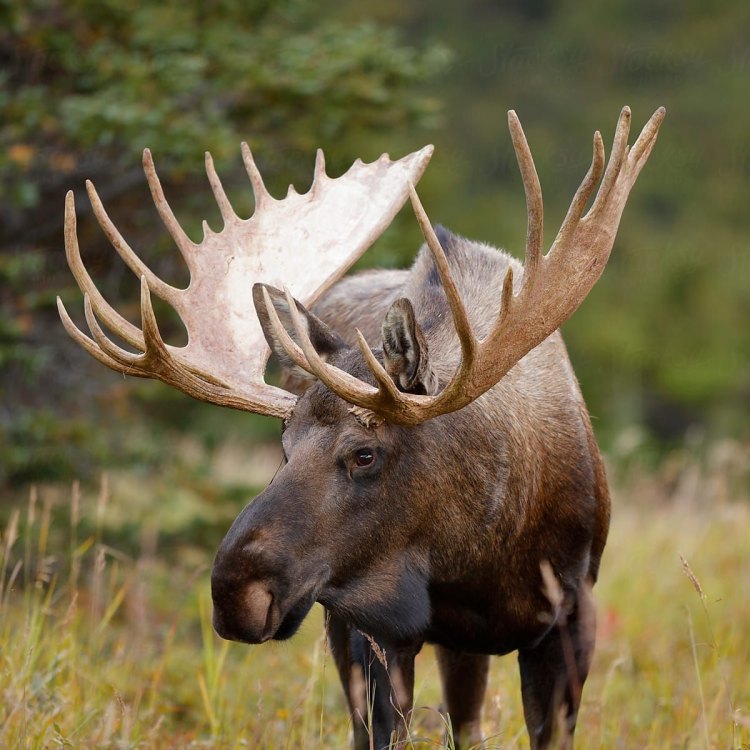
Mighty Moose: The King of the Northern Forests
Disclaimer: The content provided is for informational purposes only. We cannot guarantee the accuracy of the information on this page 100%. All information provided here may change without prior notice.

